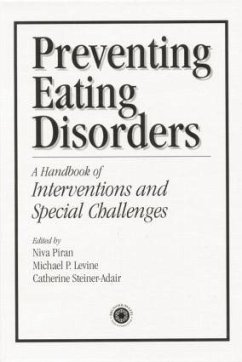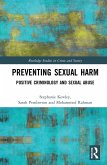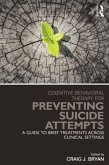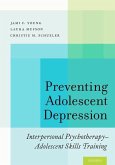Preventing Eating Disorders
A Handbook of Interventions and Special Challenges
Herausgeber: Piran, Niva; Steiner-Adair, Catherine; Levine, Michael
Preventing Eating Disorders
A Handbook of Interventions and Special Challenges
Herausgeber: Piran, Niva; Steiner-Adair, Catherine; Levine, Michael
- Broschiertes Buch
- Merkliste
- Auf die Merkliste
- Bewerten Bewerten
- Teilen
- Produkt teilen
- Produkterinnerung
- Produkterinnerung
This comprehensive resource provides multiple prevention strategies, programs, and approaches for health and mental health workers, educators, researchers, students, and interested members of the community at large who work to prevent eating disorders and related problems.
Andere Kunden interessierten sich auch für
![Preventing Sexual Harm Preventing Sexual Harm]() Stephanie KewleyPreventing Sexual Harm195,99 €
Stephanie KewleyPreventing Sexual Harm195,99 €![Cognitive Behavioral Therapy for Preventing Suicide Attempts Cognitive Behavioral Therapy for Preventing Suicide Attempts]() Cognitive Behavioral Therapy for Preventing Suicide Attempts259,99 €
Cognitive Behavioral Therapy for Preventing Suicide Attempts259,99 €![Cognitive Behavioral Therapy for Preventing Suicide Attempts Cognitive Behavioral Therapy for Preventing Suicide Attempts]() Cognitive Behavioral Therapy for Preventing Suicide Attempts63,99 €
Cognitive Behavioral Therapy for Preventing Suicide Attempts63,99 €![Preventing Adolescent Depression Preventing Adolescent Depression]() Jami F. YoungPreventing Adolescent Depression49,99 €
Jami F. YoungPreventing Adolescent Depression49,99 €![Preventing Teen Violence Preventing Teen Violence]() Sherri McCarthyPreventing Teen Violence102,99 €
Sherri McCarthyPreventing Teen Violence102,99 €![Current Findings on Males with Eating Disorders Current Findings on Males with Eating Disorders]() Current Findings on Males with Eating Disorders227,99 €
Current Findings on Males with Eating Disorders227,99 €![Compulsive Exercise And The Eating Disorders Compulsive Exercise And The Eating Disorders]() Alayne YatesCompulsive Exercise And The Eating Disorders68,99 €
Alayne YatesCompulsive Exercise And The Eating Disorders68,99 €-
-
-
This comprehensive resource provides multiple prevention strategies, programs, and approaches for health and mental health workers, educators, researchers, students, and interested members of the community at large who work to prevent eating disorders and related problems.
Hinweis: Dieser Artikel kann nur an eine deutsche Lieferadresse ausgeliefert werden.
Hinweis: Dieser Artikel kann nur an eine deutsche Lieferadresse ausgeliefert werden.
Produktdetails
- Produktdetails
- Verlag: Routledge
- Seitenzahl: 372
- Erscheinungstermin: 22. Dezember 2014
- Englisch
- Abmessung: 234mm x 156mm x 20mm
- Gewicht: 565g
- ISBN-13: 9781138005167
- ISBN-10: 1138005169
- Artikelnr.: 40813668
- Herstellerkennzeichnung
- Libri GmbH
- Europaallee 1
- 36244 Bad Hersfeld
- gpsr@libri.de
- Verlag: Routledge
- Seitenzahl: 372
- Erscheinungstermin: 22. Dezember 2014
- Englisch
- Abmessung: 234mm x 156mm x 20mm
- Gewicht: 565g
- ISBN-13: 9781138005167
- ISBN-10: 1138005169
- Artikelnr.: 40813668
- Herstellerkennzeichnung
- Libri GmbH
- Europaallee 1
- 36244 Bad Hersfeld
- gpsr@libri.de
Catherine Steiner-Adair, Niva Piran, Michael Levine
Part I. Addressing Societal Institutions and Values. Mission More Probable:
Media Literacy, Activism, and Advocacy as Primary Prevention. Eating
Disorders: Transcultural Perspectives Inform Prevention. The Role of
Parents in the Emergence, Maintenance, and Prevention of Eating Problems
and Disorders. The Bolder Model of Prevention: Science, Practice, and
Activism. Part II. Prevention Programs for Elementary and Middle Schools.
Elementary School Curricula for the Primary Prevention of Eating Problems.
Resisting Weightism: Media Literacy for Elementary School Children.
Discussion Groups for Girls: Decoding the Language of Fat. Peer Relations,
Body Image and Disordered Eating Adolescent Girls: Implications for
Prevention. The Reduction of Preoccupation with Body Weight and Shape in
Schools: A Feminist Approach. Part III. Prevention Programs for High
Schools and Colleges. The Efficacy of Eating Disorder School-Based
Prevention Programs: Building Physical Self-Esteem and Personal
Competencies. The Looking Good, Feeling Good Program: A Multi-Ethnic
Intervention for Healthy Body Image, Nutrition, and Physical Activity.
Sexual Harassment and the Prevention of Eating Disorders: Educating Young
Women. An Integrated Prevention Intervention Program. The Panhellenic Task
Force on Eating Disorders: A Program of Primary and Secondary Prevention
for Sororities. Part IV. Special Challenges: High Risk Populations and
Secondary Prevention. Small Victories: Prevention of Eating Disorders among
Elite Athletes. On the Move from Tertiary to Secondary and Primary
Prevention: Working with an Elite Dance School. Preventing Eating Disorders
in Young Women with Diabetes. Working with Physicians Toward the Goal of
Primary and Secondary Prevention. Prevention of Medical Complications in
Children and Adolescents with Eating Disorders. Reflections, Conclusions,
and Future Directions.
Media Literacy, Activism, and Advocacy as Primary Prevention. Eating
Disorders: Transcultural Perspectives Inform Prevention. The Role of
Parents in the Emergence, Maintenance, and Prevention of Eating Problems
and Disorders. The Bolder Model of Prevention: Science, Practice, and
Activism. Part II. Prevention Programs for Elementary and Middle Schools.
Elementary School Curricula for the Primary Prevention of Eating Problems.
Resisting Weightism: Media Literacy for Elementary School Children.
Discussion Groups for Girls: Decoding the Language of Fat. Peer Relations,
Body Image and Disordered Eating Adolescent Girls: Implications for
Prevention. The Reduction of Preoccupation with Body Weight and Shape in
Schools: A Feminist Approach. Part III. Prevention Programs for High
Schools and Colleges. The Efficacy of Eating Disorder School-Based
Prevention Programs: Building Physical Self-Esteem and Personal
Competencies. The Looking Good, Feeling Good Program: A Multi-Ethnic
Intervention for Healthy Body Image, Nutrition, and Physical Activity.
Sexual Harassment and the Prevention of Eating Disorders: Educating Young
Women. An Integrated Prevention Intervention Program. The Panhellenic Task
Force on Eating Disorders: A Program of Primary and Secondary Prevention
for Sororities. Part IV. Special Challenges: High Risk Populations and
Secondary Prevention. Small Victories: Prevention of Eating Disorders among
Elite Athletes. On the Move from Tertiary to Secondary and Primary
Prevention: Working with an Elite Dance School. Preventing Eating Disorders
in Young Women with Diabetes. Working with Physicians Toward the Goal of
Primary and Secondary Prevention. Prevention of Medical Complications in
Children and Adolescents with Eating Disorders. Reflections, Conclusions,
and Future Directions.
Part I. Addressing Societal Institutions and Values. Mission More Probable:
Media Literacy, Activism, and Advocacy as Primary Prevention. Eating
Disorders: Transcultural Perspectives Inform Prevention. The Role of
Parents in the Emergence, Maintenance, and Prevention of Eating Problems
and Disorders. The Bolder Model of Prevention: Science, Practice, and
Activism. Part II. Prevention Programs for Elementary and Middle Schools.
Elementary School Curricula for the Primary Prevention of Eating Problems.
Resisting Weightism: Media Literacy for Elementary School Children.
Discussion Groups for Girls: Decoding the Language of Fat. Peer Relations,
Body Image and Disordered Eating Adolescent Girls: Implications for
Prevention. The Reduction of Preoccupation with Body Weight and Shape in
Schools: A Feminist Approach. Part III. Prevention Programs for High
Schools and Colleges. The Efficacy of Eating Disorder School-Based
Prevention Programs: Building Physical Self-Esteem and Personal
Competencies. The Looking Good, Feeling Good Program: A Multi-Ethnic
Intervention for Healthy Body Image, Nutrition, and Physical Activity.
Sexual Harassment and the Prevention of Eating Disorders: Educating Young
Women. An Integrated Prevention Intervention Program. The Panhellenic Task
Force on Eating Disorders: A Program of Primary and Secondary Prevention
for Sororities. Part IV. Special Challenges: High Risk Populations and
Secondary Prevention. Small Victories: Prevention of Eating Disorders among
Elite Athletes. On the Move from Tertiary to Secondary and Primary
Prevention: Working with an Elite Dance School. Preventing Eating Disorders
in Young Women with Diabetes. Working with Physicians Toward the Goal of
Primary and Secondary Prevention. Prevention of Medical Complications in
Children and Adolescents with Eating Disorders. Reflections, Conclusions,
and Future Directions.
Media Literacy, Activism, and Advocacy as Primary Prevention. Eating
Disorders: Transcultural Perspectives Inform Prevention. The Role of
Parents in the Emergence, Maintenance, and Prevention of Eating Problems
and Disorders. The Bolder Model of Prevention: Science, Practice, and
Activism. Part II. Prevention Programs for Elementary and Middle Schools.
Elementary School Curricula for the Primary Prevention of Eating Problems.
Resisting Weightism: Media Literacy for Elementary School Children.
Discussion Groups for Girls: Decoding the Language of Fat. Peer Relations,
Body Image and Disordered Eating Adolescent Girls: Implications for
Prevention. The Reduction of Preoccupation with Body Weight and Shape in
Schools: A Feminist Approach. Part III. Prevention Programs for High
Schools and Colleges. The Efficacy of Eating Disorder School-Based
Prevention Programs: Building Physical Self-Esteem and Personal
Competencies. The Looking Good, Feeling Good Program: A Multi-Ethnic
Intervention for Healthy Body Image, Nutrition, and Physical Activity.
Sexual Harassment and the Prevention of Eating Disorders: Educating Young
Women. An Integrated Prevention Intervention Program. The Panhellenic Task
Force on Eating Disorders: A Program of Primary and Secondary Prevention
for Sororities. Part IV. Special Challenges: High Risk Populations and
Secondary Prevention. Small Victories: Prevention of Eating Disorders among
Elite Athletes. On the Move from Tertiary to Secondary and Primary
Prevention: Working with an Elite Dance School. Preventing Eating Disorders
in Young Women with Diabetes. Working with Physicians Toward the Goal of
Primary and Secondary Prevention. Prevention of Medical Complications in
Children and Adolescents with Eating Disorders. Reflections, Conclusions,
and Future Directions.








